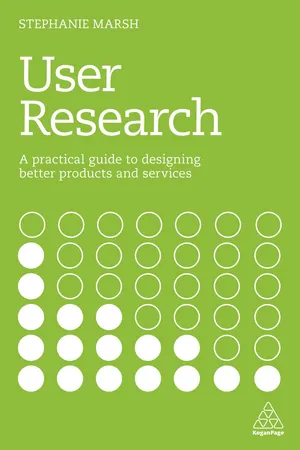
User Research
A Practical Guide to Designing Better Products and Services
Stephanie Marsh
- English
- ePUB (mobile friendly)
- Available on iOS & Android
User Research
A Practical Guide to Designing Better Products and Services
Stephanie Marsh
About This Book
Many businesses are based on creating desirable experiences, products and services for users. However in spite of this, companies often fail to consider the end user - the customer - in their planning and development processes. As a result, organizations find themselves spending huge sums of money creating products and services that, quite simply, don't work. User experience research, also known as UX research, focuses on understanding user behaviours, needs and motivations through a range of observational techniques, task analysis and other methodologies.
User Research is a practical guide that shows readers how to use the vast array of user research methods available. Covering all the key research methods including face-to-face user testing, card sorting, surveys, A/B testing and many more, the book gives expert insight into the nuances, advantages and disadvantages of each, while also providing guidance on how to interpret, analyze and share the data once it has been obtained.
Ultimately, User Research is about putting natural powers of observation and conversation to use in a specific way. The book isn't bogged down with small, specific, technical detail - rather, it explores the fundamentals of user research, which remain true regardless of the context in which they are applied. As such, the tools and frameworks given here can be used in any sector or industry, to improve any part of the customer journey and experience; whether that means improving software, websites, customer services, products, packaging or more.
Frequently asked questions
PART ONE
The fundamentals. What good research looks like
02
Planning, objectives and legalities in user research
When is the right time to do user research?
Be clear what your research is about
What’s your problem?
Be aware of the ethical and legal issues
Do not skip this section!
- Whether you are going to record data in some way (video, audio, screen, survey data capture, etc).
- What you will do with the data (will it be used only for this research? Who will you share it with: people in your organization; people outside your organization?)
- How will you sort the data? Will it be secure?
- How long will you store that data: until the end of the project, for a year, forever?
Table of contents
- Cover
- Title Page
- Copyright
- Contents
- Preface and acknowledgements
- 01 Introduction: why is user research so important?
- PART ONE The fundamentals: What good research looks like
- PART TWO Selecting and using user research methods
- PART THREE Analysing and presenting your data
- Index
- Backcover